Marketing Environment Report: Analyzing Disney's Strategies (MGK1201)
VerifiedAdded on 2022/12/28
|9
|1866
|39
Report
AI Summary
This report provides a comprehensive analysis of The Walt Disney Company's marketing environment. It begins with an introduction to the marketing environment, emphasizing both internal and external factors influencing Disney's operations. The report delves into Disney's strategic approach to customer experience, targeting various demographics from children to adults. It analyzes the macroenvironment, including socio-cultural and technological factors, and their impact on Disney's performance. The microenvironment, encompassing customers, competitors, suppliers, and marketing intermediaries, is also examined. The core of the report focuses on the four Ps of marketing: product, price, place, and promotion. It explores Disney's diversified product lines, value-based pricing strategies, distribution channels, and promotional activities. The report highlights Disney's ability to adapt to changing customer behaviors and leverage technology to enhance customer engagement and brand awareness. Finally, the report concludes by summarizing Disney's effective management of market trends and its strategic focus on delivering value to its customers.
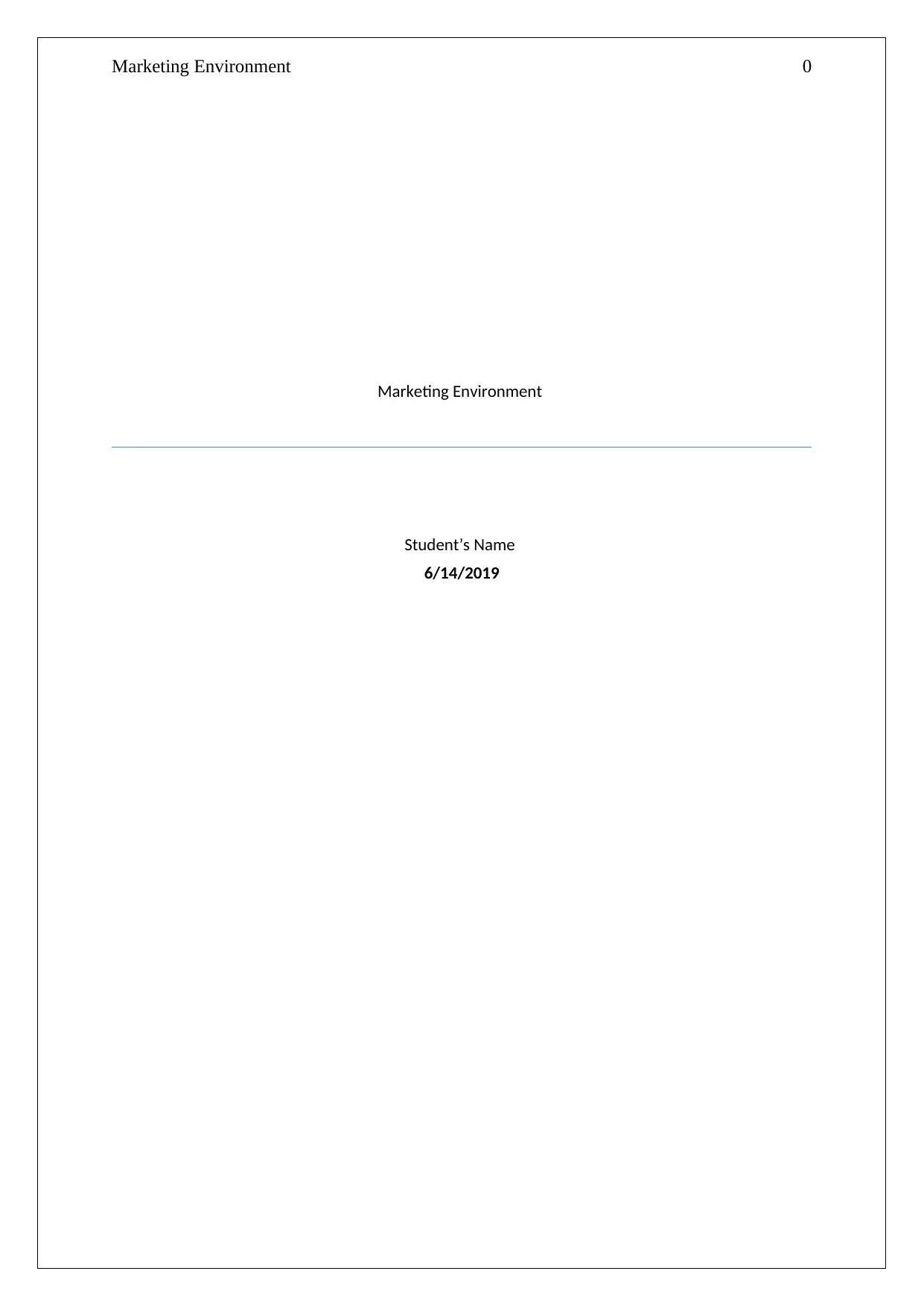
Marketing Environment 0
Marketing Environment
Student’s Name
6/14/2019
Marketing Environment
Student’s Name
6/14/2019
Paraphrase This Document
Need a fresh take? Get an instant paraphrase of this document with our AI Paraphraser
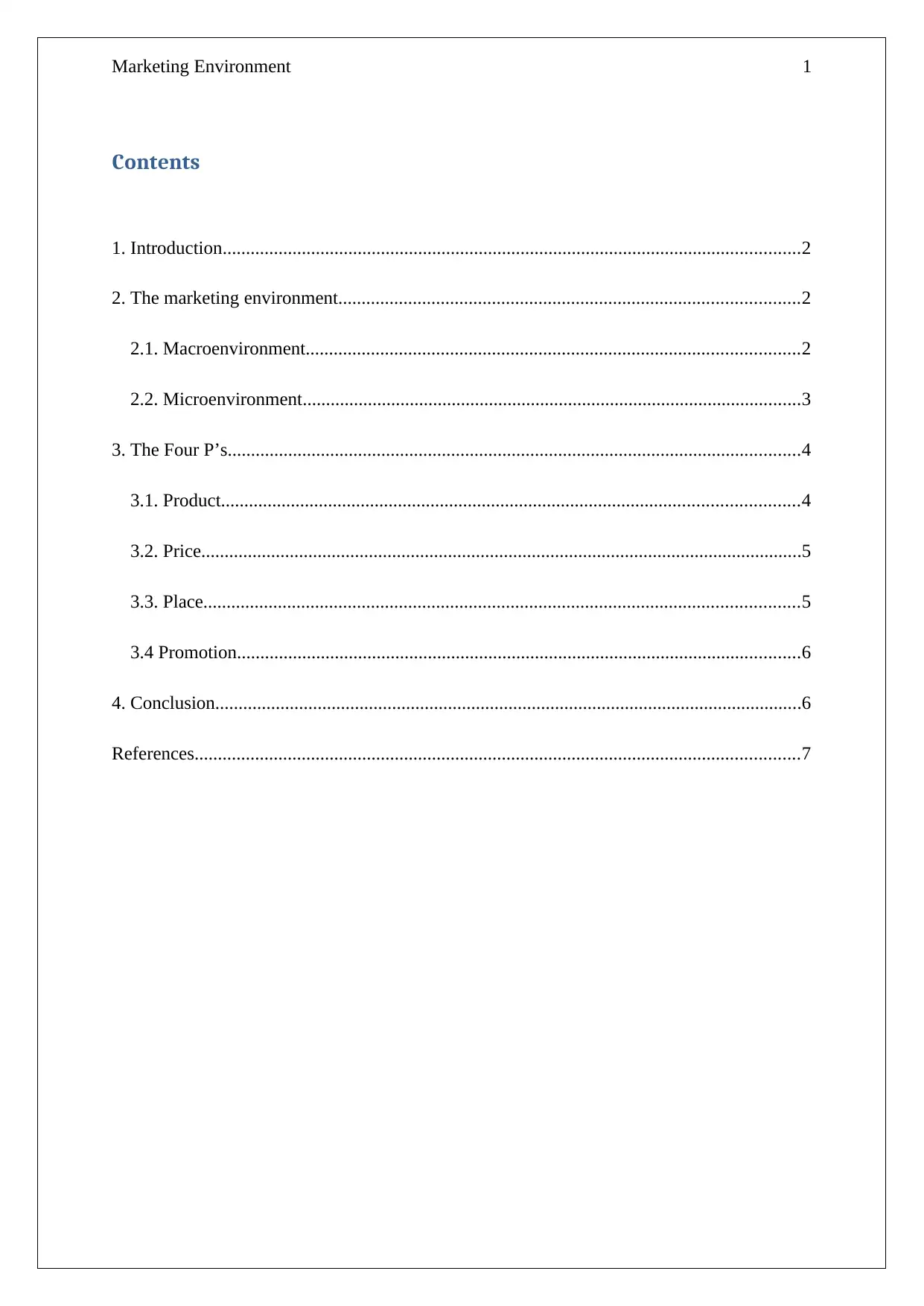
Marketing Environment 1
Contents
1. Introduction............................................................................................................................2
2. The marketing environment...................................................................................................2
2.1. Macroenvironment..........................................................................................................2
2.2. Microenvironment...........................................................................................................3
3. The Four P’s...........................................................................................................................4
3.1. Product............................................................................................................................4
3.2. Price.................................................................................................................................5
3.3. Place................................................................................................................................5
3.4 Promotion.........................................................................................................................6
4. Conclusion..............................................................................................................................6
References..................................................................................................................................7
Contents
1. Introduction............................................................................................................................2
2. The marketing environment...................................................................................................2
2.1. Macroenvironment..........................................................................................................2
2.2. Microenvironment...........................................................................................................3
3. The Four P’s...........................................................................................................................4
3.1. Product............................................................................................................................4
3.2. Price.................................................................................................................................5
3.3. Place................................................................................................................................5
3.4 Promotion.........................................................................................................................6
4. Conclusion..............................................................................................................................6
References..................................................................................................................................7
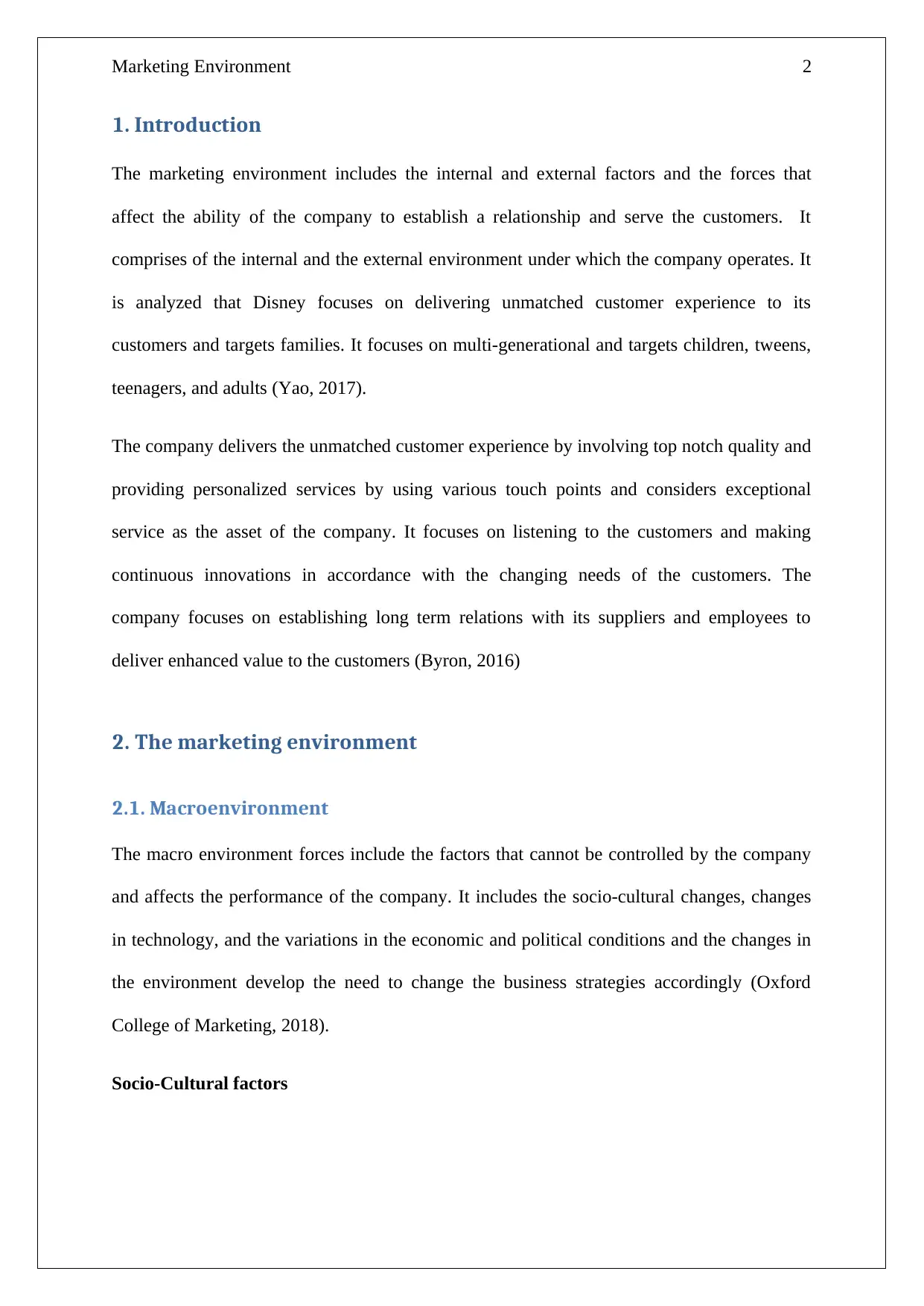
Marketing Environment 2
1. Introduction
The marketing environment includes the internal and external factors and the forces that
affect the ability of the company to establish a relationship and serve the customers. It
comprises of the internal and the external environment under which the company operates. It
is analyzed that Disney focuses on delivering unmatched customer experience to its
customers and targets families. It focuses on multi-generational and targets children, tweens,
teenagers, and adults (Yao, 2017).
The company delivers the unmatched customer experience by involving top notch quality and
providing personalized services by using various touch points and considers exceptional
service as the asset of the company. It focuses on listening to the customers and making
continuous innovations in accordance with the changing needs of the customers. The
company focuses on establishing long term relations with its suppliers and employees to
deliver enhanced value to the customers (Byron, 2016)
2. The marketing environment
2.1. Macroenvironment
The macro environment forces include the factors that cannot be controlled by the company
and affects the performance of the company. It includes the socio-cultural changes, changes
in technology, and the variations in the economic and political conditions and the changes in
the environment develop the need to change the business strategies accordingly (Oxford
College of Marketing, 2018).
Socio-Cultural factors
1. Introduction
The marketing environment includes the internal and external factors and the forces that
affect the ability of the company to establish a relationship and serve the customers. It
comprises of the internal and the external environment under which the company operates. It
is analyzed that Disney focuses on delivering unmatched customer experience to its
customers and targets families. It focuses on multi-generational and targets children, tweens,
teenagers, and adults (Yao, 2017).
The company delivers the unmatched customer experience by involving top notch quality and
providing personalized services by using various touch points and considers exceptional
service as the asset of the company. It focuses on listening to the customers and making
continuous innovations in accordance with the changing needs of the customers. The
company focuses on establishing long term relations with its suppliers and employees to
deliver enhanced value to the customers (Byron, 2016)
2. The marketing environment
2.1. Macroenvironment
The macro environment forces include the factors that cannot be controlled by the company
and affects the performance of the company. It includes the socio-cultural changes, changes
in technology, and the variations in the economic and political conditions and the changes in
the environment develop the need to change the business strategies accordingly (Oxford
College of Marketing, 2018).
Socio-Cultural factors
⊘ This is a preview!⊘
Do you want full access?
Subscribe today to unlock all pages.

Trusted by 1+ million students worldwide
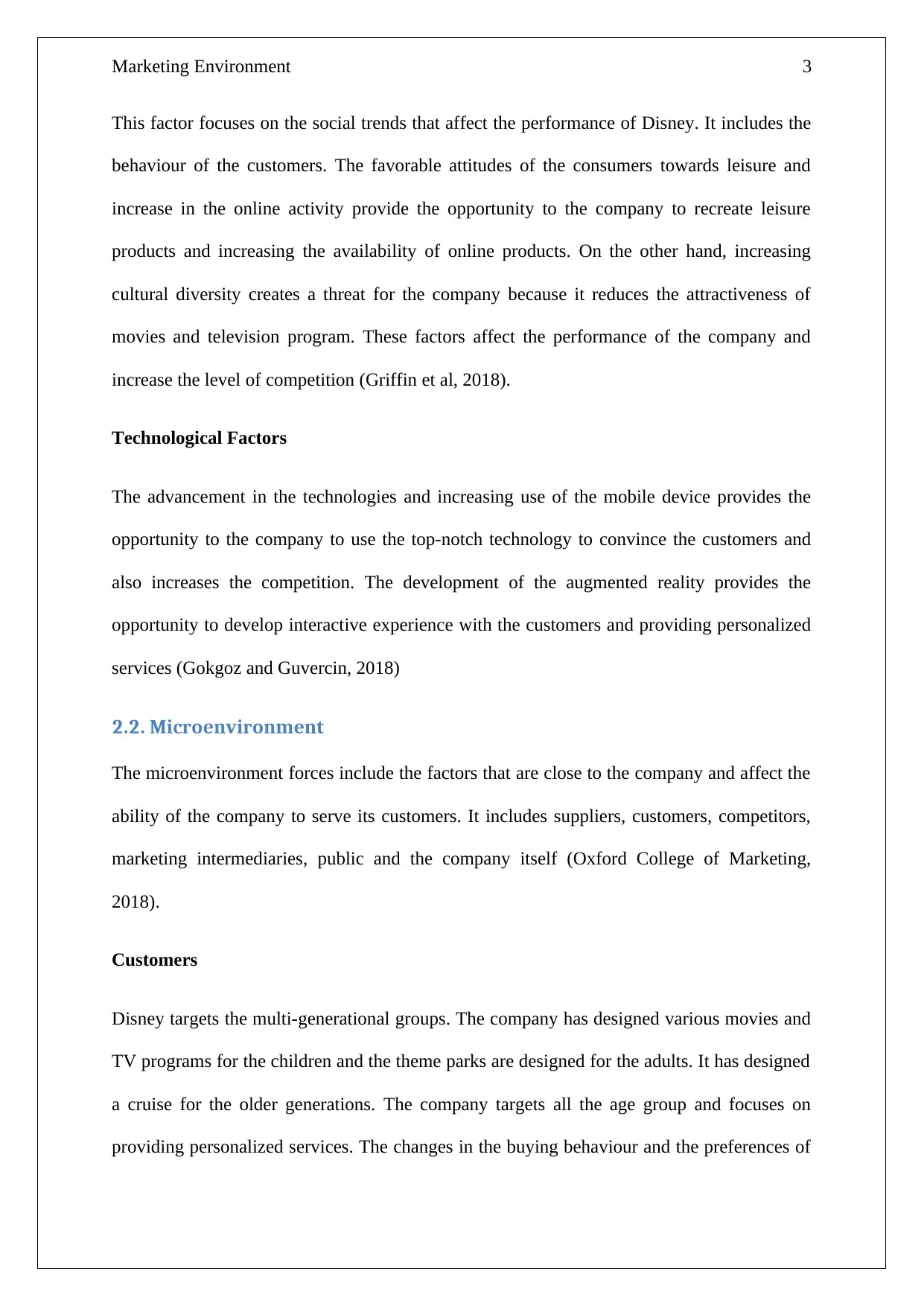
Marketing Environment 3
This factor focuses on the social trends that affect the performance of Disney. It includes the
behaviour of the customers. The favorable attitudes of the consumers towards leisure and
increase in the online activity provide the opportunity to the company to recreate leisure
products and increasing the availability of online products. On the other hand, increasing
cultural diversity creates a threat for the company because it reduces the attractiveness of
movies and television program. These factors affect the performance of the company and
increase the level of competition (Griffin et al, 2018).
Technological Factors
The advancement in the technologies and increasing use of the mobile device provides the
opportunity to the company to use the top-notch technology to convince the customers and
also increases the competition. The development of the augmented reality provides the
opportunity to develop interactive experience with the customers and providing personalized
services (Gokgoz and Guvercin, 2018)
2.2. Microenvironment
The microenvironment forces include the factors that are close to the company and affect the
ability of the company to serve its customers. It includes suppliers, customers, competitors,
marketing intermediaries, public and the company itself (Oxford College of Marketing,
2018).
Customers
Disney targets the multi-generational groups. The company has designed various movies and
TV programs for the children and the theme parks are designed for the adults. It has designed
a cruise for the older generations. The company targets all the age group and focuses on
providing personalized services. The changes in the buying behaviour and the preferences of
This factor focuses on the social trends that affect the performance of Disney. It includes the
behaviour of the customers. The favorable attitudes of the consumers towards leisure and
increase in the online activity provide the opportunity to the company to recreate leisure
products and increasing the availability of online products. On the other hand, increasing
cultural diversity creates a threat for the company because it reduces the attractiveness of
movies and television program. These factors affect the performance of the company and
increase the level of competition (Griffin et al, 2018).
Technological Factors
The advancement in the technologies and increasing use of the mobile device provides the
opportunity to the company to use the top-notch technology to convince the customers and
also increases the competition. The development of the augmented reality provides the
opportunity to develop interactive experience with the customers and providing personalized
services (Gokgoz and Guvercin, 2018)
2.2. Microenvironment
The microenvironment forces include the factors that are close to the company and affect the
ability of the company to serve its customers. It includes suppliers, customers, competitors,
marketing intermediaries, public and the company itself (Oxford College of Marketing,
2018).
Customers
Disney targets the multi-generational groups. The company has designed various movies and
TV programs for the children and the theme parks are designed for the adults. It has designed
a cruise for the older generations. The company targets all the age group and focuses on
providing personalized services. The changes in the buying behaviour and the preferences of
Paraphrase This Document
Need a fresh take? Get an instant paraphrase of this document with our AI Paraphraser
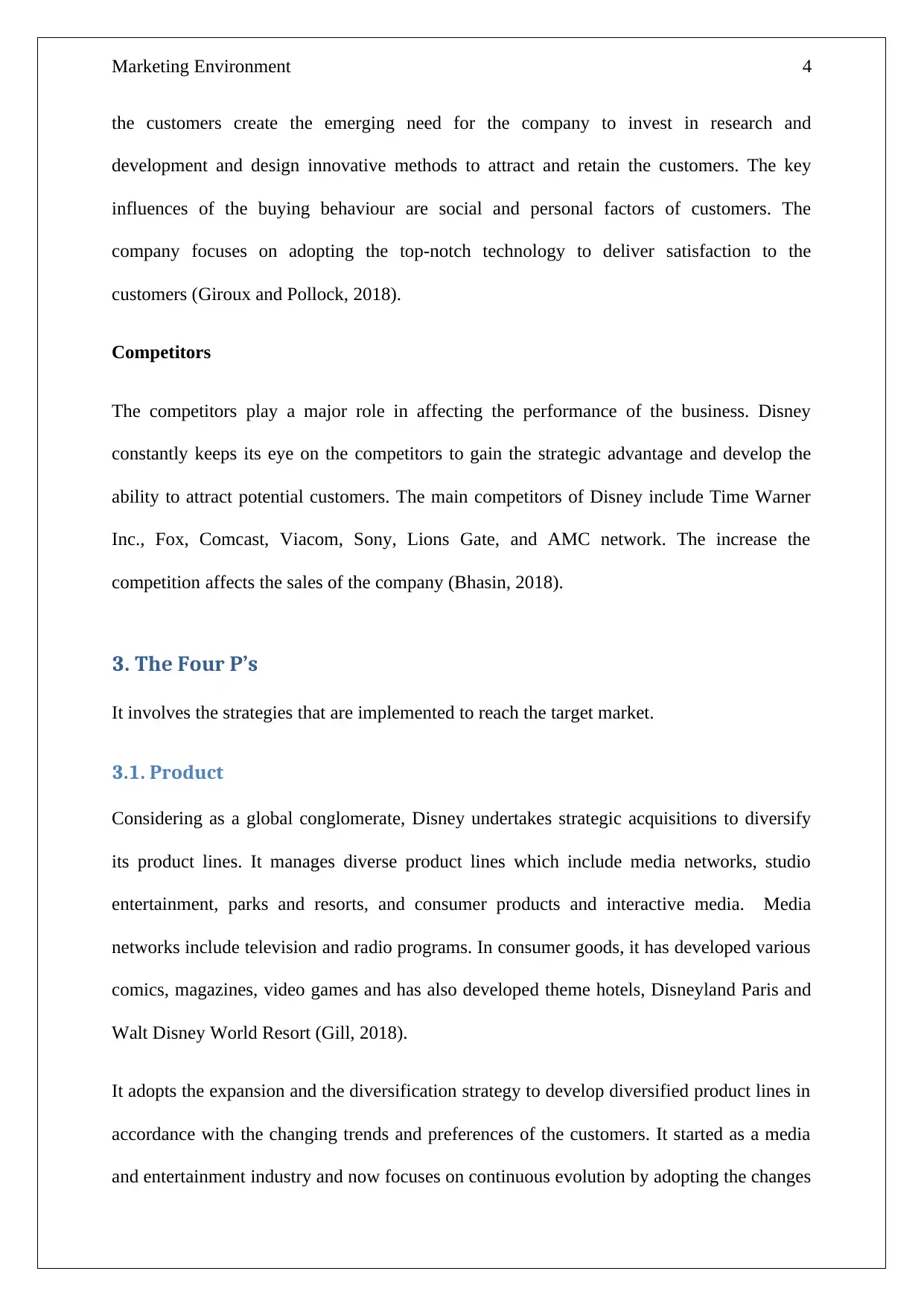
Marketing Environment 4
the customers create the emerging need for the company to invest in research and
development and design innovative methods to attract and retain the customers. The key
influences of the buying behaviour are social and personal factors of customers. The
company focuses on adopting the top-notch technology to deliver satisfaction to the
customers (Giroux and Pollock, 2018).
Competitors
The competitors play a major role in affecting the performance of the business. Disney
constantly keeps its eye on the competitors to gain the strategic advantage and develop the
ability to attract potential customers. The main competitors of Disney include Time Warner
Inc., Fox, Comcast, Viacom, Sony, Lions Gate, and AMC network. The increase the
competition affects the sales of the company (Bhasin, 2018).
3. The Four P’s
It involves the strategies that are implemented to reach the target market.
3.1. Product
Considering as a global conglomerate, Disney undertakes strategic acquisitions to diversify
its product lines. It manages diverse product lines which include media networks, studio
entertainment, parks and resorts, and consumer products and interactive media. Media
networks include television and radio programs. In consumer goods, it has developed various
comics, magazines, video games and has also developed theme hotels, Disneyland Paris and
Walt Disney World Resort (Gill, 2018).
It adopts the expansion and the diversification strategy to develop diversified product lines in
accordance with the changing trends and preferences of the customers. It started as a media
and entertainment industry and now focuses on continuous evolution by adopting the changes
the customers create the emerging need for the company to invest in research and
development and design innovative methods to attract and retain the customers. The key
influences of the buying behaviour are social and personal factors of customers. The
company focuses on adopting the top-notch technology to deliver satisfaction to the
customers (Giroux and Pollock, 2018).
Competitors
The competitors play a major role in affecting the performance of the business. Disney
constantly keeps its eye on the competitors to gain the strategic advantage and develop the
ability to attract potential customers. The main competitors of Disney include Time Warner
Inc., Fox, Comcast, Viacom, Sony, Lions Gate, and AMC network. The increase the
competition affects the sales of the company (Bhasin, 2018).
3. The Four P’s
It involves the strategies that are implemented to reach the target market.
3.1. Product
Considering as a global conglomerate, Disney undertakes strategic acquisitions to diversify
its product lines. It manages diverse product lines which include media networks, studio
entertainment, parks and resorts, and consumer products and interactive media. Media
networks include television and radio programs. In consumer goods, it has developed various
comics, magazines, video games and has also developed theme hotels, Disneyland Paris and
Walt Disney World Resort (Gill, 2018).
It adopts the expansion and the diversification strategy to develop diversified product lines in
accordance with the changing trends and preferences of the customers. It started as a media
and entertainment industry and now focuses on continuous evolution by adopting the changes
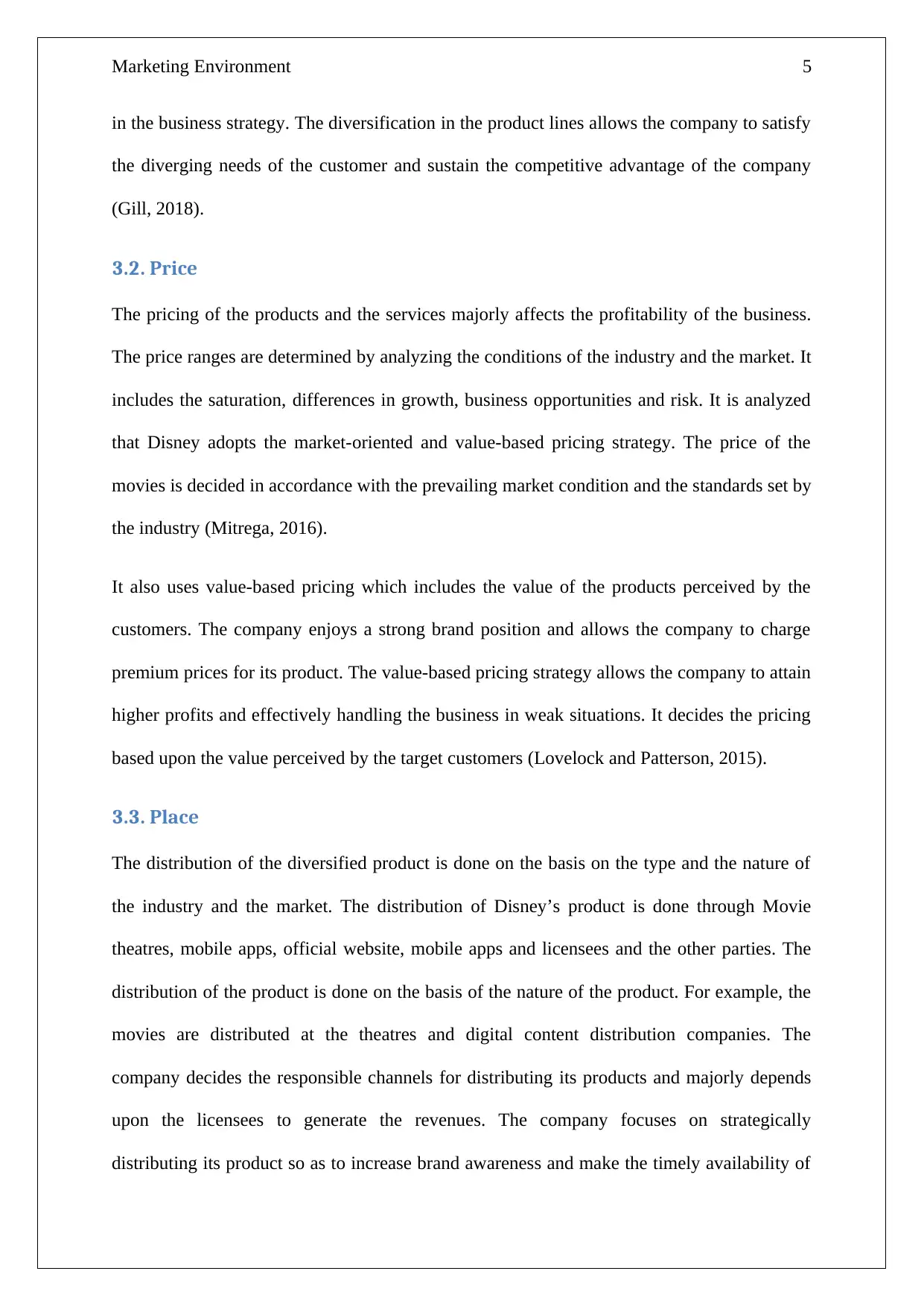
Marketing Environment 5
in the business strategy. The diversification in the product lines allows the company to satisfy
the diverging needs of the customer and sustain the competitive advantage of the company
(Gill, 2018).
3.2. Price
The pricing of the products and the services majorly affects the profitability of the business.
The price ranges are determined by analyzing the conditions of the industry and the market. It
includes the saturation, differences in growth, business opportunities and risk. It is analyzed
that Disney adopts the market-oriented and value-based pricing strategy. The price of the
movies is decided in accordance with the prevailing market condition and the standards set by
the industry (Mitrega, 2016).
It also uses value-based pricing which includes the value of the products perceived by the
customers. The company enjoys a strong brand position and allows the company to charge
premium prices for its product. The value-based pricing strategy allows the company to attain
higher profits and effectively handling the business in weak situations. It decides the pricing
based upon the value perceived by the target customers (Lovelock and Patterson, 2015).
3.3. Place
The distribution of the diversified product is done on the basis on the type and the nature of
the industry and the market. The distribution of Disney’s product is done through Movie
theatres, mobile apps, official website, mobile apps and licensees and the other parties. The
distribution of the product is done on the basis of the nature of the product. For example, the
movies are distributed at the theatres and digital content distribution companies. The
company decides the responsible channels for distributing its products and majorly depends
upon the licensees to generate the revenues. The company focuses on strategically
distributing its product so as to increase brand awareness and make the timely availability of
in the business strategy. The diversification in the product lines allows the company to satisfy
the diverging needs of the customer and sustain the competitive advantage of the company
(Gill, 2018).
3.2. Price
The pricing of the products and the services majorly affects the profitability of the business.
The price ranges are determined by analyzing the conditions of the industry and the market. It
includes the saturation, differences in growth, business opportunities and risk. It is analyzed
that Disney adopts the market-oriented and value-based pricing strategy. The price of the
movies is decided in accordance with the prevailing market condition and the standards set by
the industry (Mitrega, 2016).
It also uses value-based pricing which includes the value of the products perceived by the
customers. The company enjoys a strong brand position and allows the company to charge
premium prices for its product. The value-based pricing strategy allows the company to attain
higher profits and effectively handling the business in weak situations. It decides the pricing
based upon the value perceived by the target customers (Lovelock and Patterson, 2015).
3.3. Place
The distribution of the diversified product is done on the basis on the type and the nature of
the industry and the market. The distribution of Disney’s product is done through Movie
theatres, mobile apps, official website, mobile apps and licensees and the other parties. The
distribution of the product is done on the basis of the nature of the product. For example, the
movies are distributed at the theatres and digital content distribution companies. The
company decides the responsible channels for distributing its products and majorly depends
upon the licensees to generate the revenues. The company focuses on strategically
distributing its product so as to increase brand awareness and make the timely availability of
⊘ This is a preview!⊘
Do you want full access?
Subscribe today to unlock all pages.

Trusted by 1+ million students worldwide
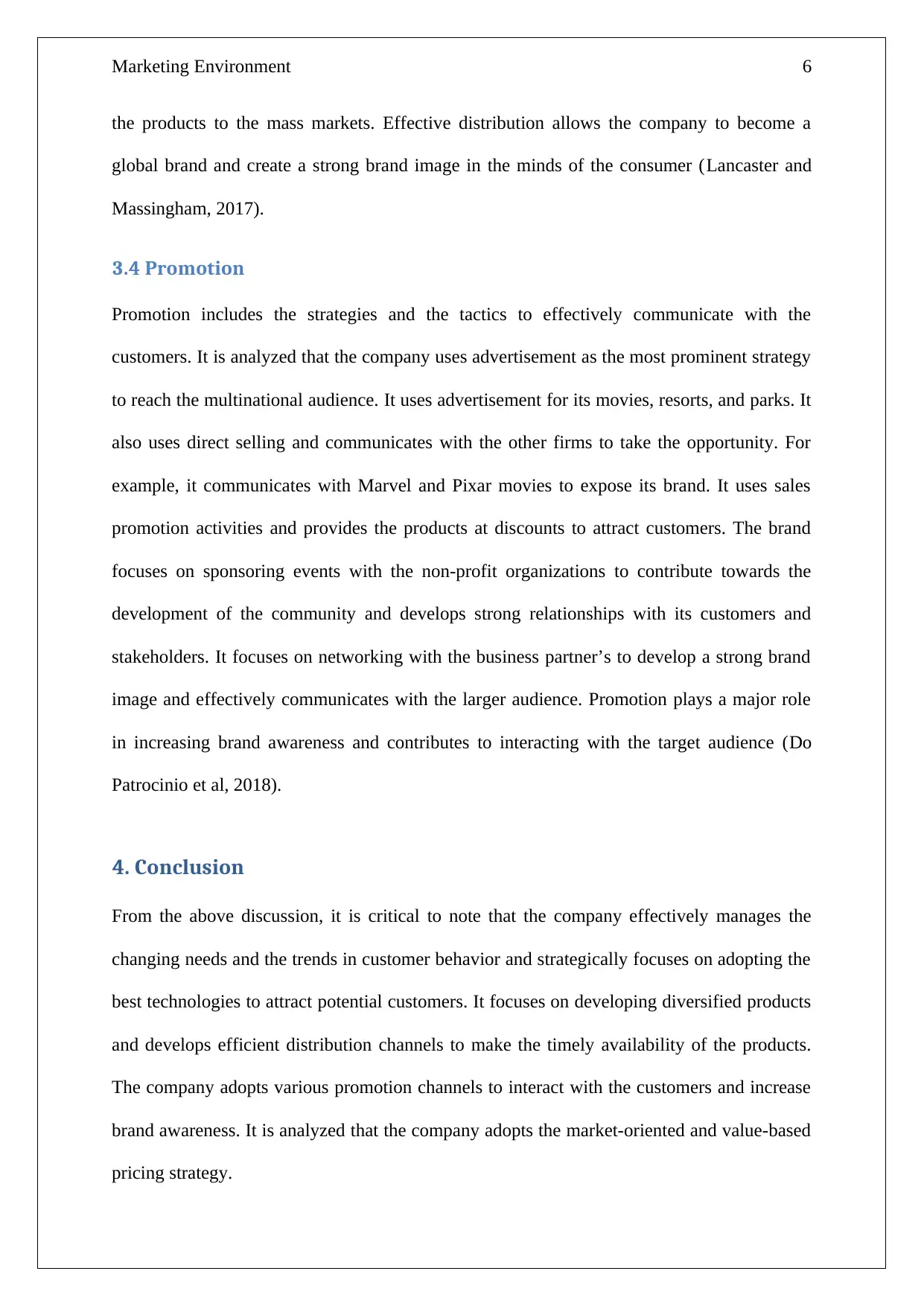
Marketing Environment 6
the products to the mass markets. Effective distribution allows the company to become a
global brand and create a strong brand image in the minds of the consumer (Lancaster and
Massingham, 2017).
3.4 Promotion
Promotion includes the strategies and the tactics to effectively communicate with the
customers. It is analyzed that the company uses advertisement as the most prominent strategy
to reach the multinational audience. It uses advertisement for its movies, resorts, and parks. It
also uses direct selling and communicates with the other firms to take the opportunity. For
example, it communicates with Marvel and Pixar movies to expose its brand. It uses sales
promotion activities and provides the products at discounts to attract customers. The brand
focuses on sponsoring events with the non-profit organizations to contribute towards the
development of the community and develops strong relationships with its customers and
stakeholders. It focuses on networking with the business partner’s to develop a strong brand
image and effectively communicates with the larger audience. Promotion plays a major role
in increasing brand awareness and contributes to interacting with the target audience (Do
Patrocinio et al, 2018).
4. Conclusion
From the above discussion, it is critical to note that the company effectively manages the
changing needs and the trends in customer behavior and strategically focuses on adopting the
best technologies to attract potential customers. It focuses on developing diversified products
and develops efficient distribution channels to make the timely availability of the products.
The company adopts various promotion channels to interact with the customers and increase
brand awareness. It is analyzed that the company adopts the market-oriented and value-based
pricing strategy.
the products to the mass markets. Effective distribution allows the company to become a
global brand and create a strong brand image in the minds of the consumer (Lancaster and
Massingham, 2017).
3.4 Promotion
Promotion includes the strategies and the tactics to effectively communicate with the
customers. It is analyzed that the company uses advertisement as the most prominent strategy
to reach the multinational audience. It uses advertisement for its movies, resorts, and parks. It
also uses direct selling and communicates with the other firms to take the opportunity. For
example, it communicates with Marvel and Pixar movies to expose its brand. It uses sales
promotion activities and provides the products at discounts to attract customers. The brand
focuses on sponsoring events with the non-profit organizations to contribute towards the
development of the community and develops strong relationships with its customers and
stakeholders. It focuses on networking with the business partner’s to develop a strong brand
image and effectively communicates with the larger audience. Promotion plays a major role
in increasing brand awareness and contributes to interacting with the target audience (Do
Patrocinio et al, 2018).
4. Conclusion
From the above discussion, it is critical to note that the company effectively manages the
changing needs and the trends in customer behavior and strategically focuses on adopting the
best technologies to attract potential customers. It focuses on developing diversified products
and develops efficient distribution channels to make the timely availability of the products.
The company adopts various promotion channels to interact with the customers and increase
brand awareness. It is analyzed that the company adopts the market-oriented and value-based
pricing strategy.
Paraphrase This Document
Need a fresh take? Get an instant paraphrase of this document with our AI Paraphraser
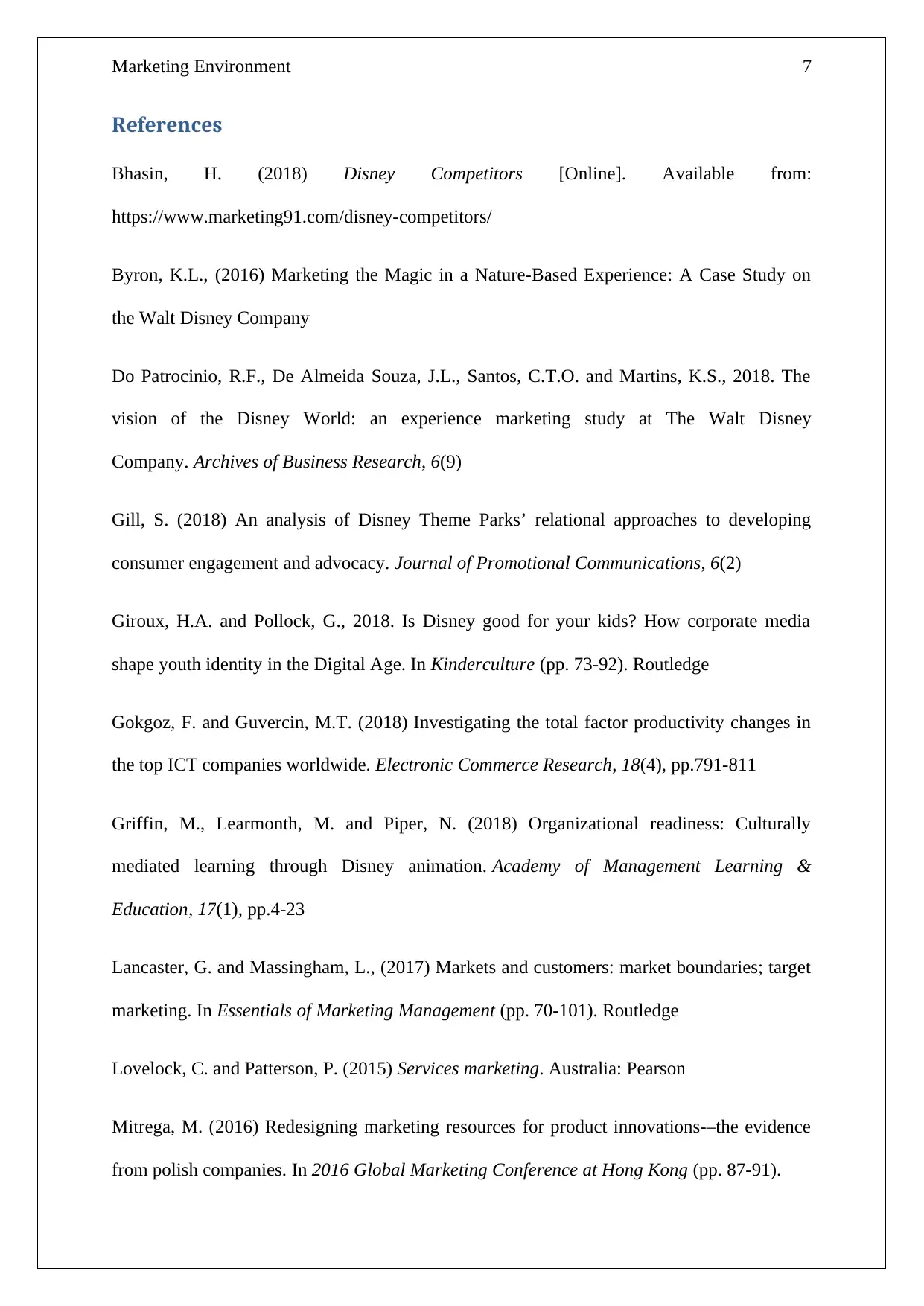
Marketing Environment 7
References
Bhasin, H. (2018) Disney Competitors [Online]. Available from:
https://www.marketing91.com/disney-competitors/
Byron, K.L., (2016) Marketing the Magic in a Nature-Based Experience: A Case Study on
the Walt Disney Company
Do Patrocinio, R.F., De Almeida Souza, J.L., Santos, C.T.O. and Martins, K.S., 2018. The
vision of the Disney World: an experience marketing study at The Walt Disney
Company. Archives of Business Research, 6(9)
Gill, S. (2018) An analysis of Disney Theme Parks’ relational approaches to developing
consumer engagement and advocacy. Journal of Promotional Communications, 6(2)
Giroux, H.A. and Pollock, G., 2018. Is Disney good for your kids? How corporate media
shape youth identity in the Digital Age. In Kinderculture (pp. 73-92). Routledge
Gokgoz, F. and Guvercin, M.T. (2018) Investigating the total factor productivity changes in
the top ICT companies worldwide. Electronic Commerce Research, 18(4), pp.791-811
Griffin, M., Learmonth, M. and Piper, N. (2018) Organizational readiness: Culturally
mediated learning through Disney animation. Academy of Management Learning &
Education, 17(1), pp.4-23
Lancaster, G. and Massingham, L., (2017) Markets and customers: market boundaries; target
marketing. In Essentials of Marketing Management (pp. 70-101). Routledge
Lovelock, C. and Patterson, P. (2015) Services marketing. Australia: Pearson
Mitrega, M. (2016) Redesigning marketing resources for product innovations-–the evidence
from polish companies. In 2016 Global Marketing Conference at Hong Kong (pp. 87-91).
References
Bhasin, H. (2018) Disney Competitors [Online]. Available from:
https://www.marketing91.com/disney-competitors/
Byron, K.L., (2016) Marketing the Magic in a Nature-Based Experience: A Case Study on
the Walt Disney Company
Do Patrocinio, R.F., De Almeida Souza, J.L., Santos, C.T.O. and Martins, K.S., 2018. The
vision of the Disney World: an experience marketing study at The Walt Disney
Company. Archives of Business Research, 6(9)
Gill, S. (2018) An analysis of Disney Theme Parks’ relational approaches to developing
consumer engagement and advocacy. Journal of Promotional Communications, 6(2)
Giroux, H.A. and Pollock, G., 2018. Is Disney good for your kids? How corporate media
shape youth identity in the Digital Age. In Kinderculture (pp. 73-92). Routledge
Gokgoz, F. and Guvercin, M.T. (2018) Investigating the total factor productivity changes in
the top ICT companies worldwide. Electronic Commerce Research, 18(4), pp.791-811
Griffin, M., Learmonth, M. and Piper, N. (2018) Organizational readiness: Culturally
mediated learning through Disney animation. Academy of Management Learning &
Education, 17(1), pp.4-23
Lancaster, G. and Massingham, L., (2017) Markets and customers: market boundaries; target
marketing. In Essentials of Marketing Management (pp. 70-101). Routledge
Lovelock, C. and Patterson, P. (2015) Services marketing. Australia: Pearson
Mitrega, M. (2016) Redesigning marketing resources for product innovations-–the evidence
from polish companies. In 2016 Global Marketing Conference at Hong Kong (pp. 87-91).
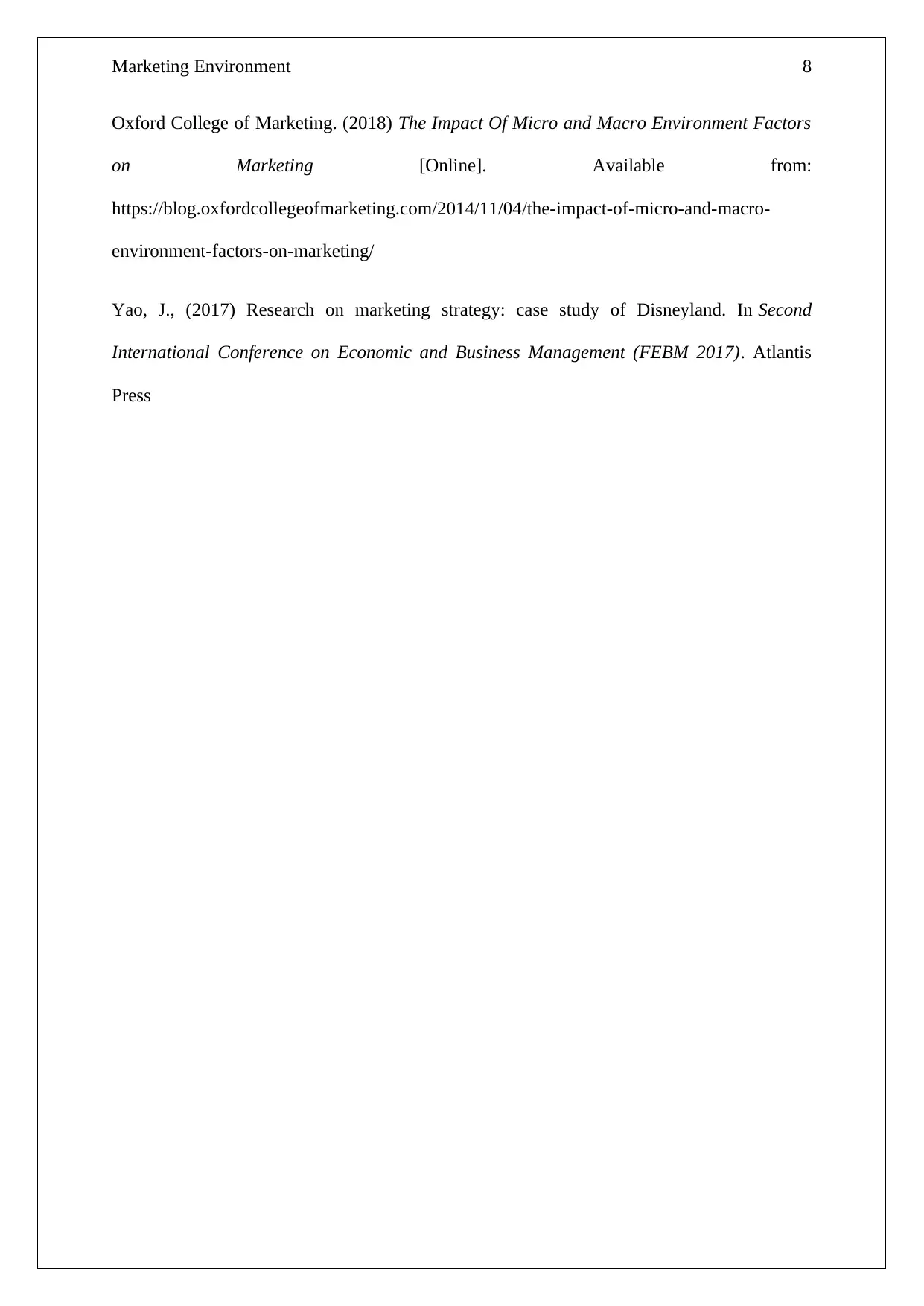
Marketing Environment 8
Oxford College of Marketing. (2018) The Impact Of Micro and Macro Environment Factors
on Marketing [Online]. Available from:
https://blog.oxfordcollegeofmarketing.com/2014/11/04/the-impact-of-micro-and-macro-
environment-factors-on-marketing/
Yao, J., (2017) Research on marketing strategy: case study of Disneyland. In Second
International Conference on Economic and Business Management (FEBM 2017). Atlantis
Press
Oxford College of Marketing. (2018) The Impact Of Micro and Macro Environment Factors
on Marketing [Online]. Available from:
https://blog.oxfordcollegeofmarketing.com/2014/11/04/the-impact-of-micro-and-macro-
environment-factors-on-marketing/
Yao, J., (2017) Research on marketing strategy: case study of Disneyland. In Second
International Conference on Economic and Business Management (FEBM 2017). Atlantis
Press
⊘ This is a preview!⊘
Do you want full access?
Subscribe today to unlock all pages.

Trusted by 1+ million students worldwide
1 out of 9
Related Documents
Your All-in-One AI-Powered Toolkit for Academic Success.
+13062052269
info@desklib.com
Available 24*7 on WhatsApp / Email
![[object Object]](/_next/static/media/star-bottom.7253800d.svg)
Unlock your academic potential
Copyright © 2020–2025 A2Z Services. All Rights Reserved. Developed and managed by ZUCOL.





